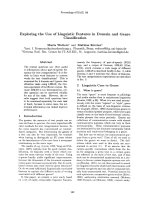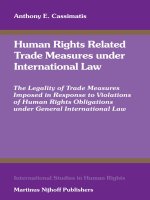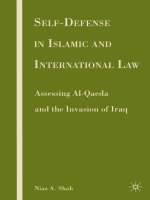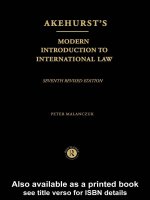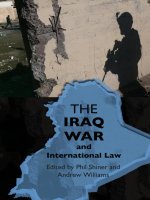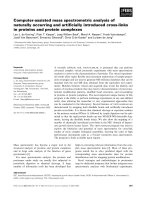Self-defense in Islamic and International Law potx
Bạn đang xem bản rút gọn của tài liệu. Xem và tải ngay bản đầy đủ của tài liệu tại đây (782.86 KB, 207 trang )
Self-defense in Islamic
and International Law
pal-shah-00fm.qxp 1/16/2008 11:06 AM Page i
Other publications:
Shah, N. A. (2006) Women, the Koran and international human rights law:
The experience of Pakistan. Leiden: Martinus Nijhoff Publishers.
pal-shah-00fm.qxp 1/16/2008 11:06 AM Page ii
Self-defense in Islamic
and International Law
Assessing Al-Qaeda
and the Invasion of Iraq
Niaz A. Shah
pal-shah-00fm.qxp 1/16/2008 11:06 AM Page iii
SELF-DEFENSE IN ISLAMIC AND INTERNATIONAL LAW
Copyright © Niaz A. Shah, 2008.
All rights reserved. No part of this book may be used or reproduced in any
manner whatsoever without written permission except in the case of brief
quotations embodied in critical articles or reviews.
First published in 2008 by
PALGRAVE MACMILLAN
TM
175 Fifth Avenue, New York, N.Y. 10010 and
Houndmills, Basingstoke, Hampshire, England RG21 6XS.
Companies and representatives throughout the world.
PALGRAVE MACMILLAN is the global academic imprint of the Palgrave
Macmillan division of St. Martin’s Press, LLC and of Palgrave Macmillan Ltd.
Macmillan® is a registered trademark in the United States, United Kingdom and
other countries. Palgrave is a registered trademark in the European Union and
other countries.
ISBN-13: 978-0-230-60618-0
ISBN-10: 0-230-60618-0
Library of Congress Cataloging-in-Publication Data
Shah, Niaz A.
Self-defense in Islamic and international law : assessing Al-Qaeda and the
invasion of Iraq / by Niaz A. Shah.
p. cm.
Includes bibliographical references and index.
ISBN 0-230-60618-0
1. Self-defense (International law) 2. Self-defense (Islamic law) 3. Al-Qaeda
(Organization) 4. Iraq War, 2003–7. Terrorism. I. Title.
KZ4043.S45 2008
341.6—dc22 2007039539
A catalogue record of the book is available from the British Library.
Design by Scribe Inc.
First edition: May 2008
10 9 8 7 6 5 4 3 2 1
Printed in the United States of America.
pal-shah-00fm.qxp 1/16/2008 11:06 AM Page iv
Dedicated to the memory of the victims
of “terrorism” and the “war on terror.”
pal-shah-00fm.qxp 1/16/2008 11:06 AM Page v
This page intentionally left blank
Contents
Preface ix
Acknowledgments xi
About the Author xiii
1 Introduction 1
Part I
2 Self-defense in Islamic Law 13
3 Al-Qaeda, the Koran, and Politics of Terrorism 47
Part II
4 Self-defense in International Law 87
5 Legality of Iraq Invasion 121
Part III
6 Self-defense in Islamic and International Law 163
7 Conclusion 173
Notes 179
Selected Bibliography 183
Index 191
pal-shah-00fm.qxp 1/16/2008 11:06 AM Page vii
This page intentionally left blank
Preface
There are many works focusing on terrorism and, after September 11, 2001,
Islamic terrorism. Writers tend to address the issue of terrorism from the per-
spective of their personal background. In many instances, it is easily discern-
able whether a work is written from a Western or a Muslim perspective. In
two respects, however, this book combines both perspectives. First, I am
looking at it from both Islamic and international legal perspectives. Second,
I write as someone who was born into and brought up in the Islamic tradi-
tion and, since 2001, has earned a living in the West.
I have had the opportunity to talk to people from both worlds. On the
issue of terrorism, when I am among Muslims, some will talk as if the entire
population in the West is against Muslims and supports the “war on terror,”
the killing of Muslims, and the destruction of their countries, such as Iraq
and Palestine. The assumption is wrong. The most severe critics of the war
on terror, for instance, are from the West. If we look at the literature on the
legality of the Iraq invasion in 2003, almost every contributor is from the
West. Even those who initially supported the war on terror are against the
current legal treatment of terror suspects, such as indefinite detention.
It is also the case that many in the West try to paint the picture as if every-
one in the Muslim world supports terrorism. Again, this is wrong. The
majority of Muslims do not support terrorism. In fact, many are ashamed of
the stigma terrorism has brought to Islam. Terrorism has also made the
Muslim communities in Europe and elsewhere appear as suspects, causing
embarrassment at airports, train stations, random police stops and searches,
and so on.
Despite the presence of critics of terrorism and of the war on terror, both
in Islamic and Western circles, we often hear only a single point of view. I am
looking at the issue of terrorism under Islamic law to show that neither
Islamic law nor Muslims support terrorism. I am looking at the war on ter-
ror from an international legal perspective (which many Muslims align with
the West) to show that many Westerners regard sending of armies in Muslim
countries, such as Iraq against international law.
pal-shah-00fm.qxp 1/16/2008 11:06 AM Page ix
This comparative analysis is intended to contribute to the breaking
down of the culture of the single narrative and to a better understanding
among people.
NAS
July 19, 2007
x
• Preface
pal-shah-00fm.qxp 1/16/2008 11:06 AM Page x
Acknowledgments
I want to acknowledge the help and support, academic and otherwise, of many
colleagues and friends during the course of writing this book. The list begins
with one of the eminent scholars of humanitarian law, Maj-Gen. (retired)
APV Rogers, Senior Fellow, Lauterpacht Research Centre for International
Law, University of Cambridge. I met him in February 2006 in the library of
the Centre by chance when we were searching the same shelf. It never occurred
to me then that he would play such a significant part in the development and
improvement of the project I had just undertaken. From the very beginning,
he had commented on the entire draft honestly and unflatteringly. Rogers
looked at every point with military precision. I am enormously grateful to him
for his comments as the book would not have been the same without them.
I am also grateful to Tony Ward, University of Hull, for his comments on
the draft and general support as a mentor. I am also grateful to Owen
Mceldowney, whom I constantly bothered to read different draft chapters. I
am also grateful to Brice Dickson, Tom Hadden, Khurshid Iqbal, Tim Sellers,
Melvin Dubnick, and Noelle Quenivet for their comments on some draft
chapters. The director of Law School at Hull University, Mike Feintuck,
kindly allowed me the time I needed for completing the draft. I appreciate it
very much.
My batch of Visiting Fellows (January–December 2006) at the
Lauterpacht Centre, where I did most of the research, needs special mention-
ing. I am particularly grateful to Judith Welling (JJ), Emily Crawford, Sara
Joseph, Amaka Okany, Elies Van Sliedregt, Melissa Perry, Martin Schaub,
Thomas Schultz, David Berry, Ralph Giles, and Gil Limon for their com-
ments and warm company. I am also grateful to Tom Grant, John Barker, M.
Shujaullah, and Kevin Boyle for their kind support. I thank Sir Elihu
Lauterpacht who is a great source of encouragement. My special thanks are
due to Shafqat Shah for her strong support at the last stages of the project.
Working with Anthony Wahl, Senior Editor, Palgrave Macmillan, New York,
is a genuine pleasure.
pal-shah-00fm.qxp 1/16/2008 11:06 AM Page xi
This page intentionally left blank
About the Author
Niaz A Shah received his PhD from The Queen’s University Belfast (2005),
took a short course in International Human Rights Law from The University
of Nottingham (2001), and received an MA (English) and LLB (1999) from
The University of Peshawar, Pakistan. Shah has written widely on human
rights issues, such as freedom of religion, honor killing, women’s rights, pub-
lic international law, and Islamic law. He is currently a Lecturer in Law at
The University of Hull, United Kingdom.
pal-shah-00fm.qxp 1/16/2008 11:06 AM Page xiii
This page intentionally left blank
CHAPTER 1
Introduction
T
he issue of terrorism is not a new one (Countering Terrorism Strategy,
UK, 2006) but the attacks of September 11, 2001, on the United
States and the responses of states have changed the notion from ter-
rorism to super-terrorism (Claridge, 2000) and mega-terrorism (Nabati,
2005). The balance between concern for democracy, civil liberties, and rule
of law and security is tipping toward concern for security (Haubrich, 2003;
Blair, 2005; Amnesty International, 2006). There is one overarching goal:
Get the terrorists wherever they are and no matter what it takes (Bush,
September 24, 2001). It may involve stretching international law beyond its
elasticity (see 4.4); marginalizing the Security Council (see 5.3); breaching
human rights standards (see 3.2); forging alliances with dictators (Pakistan)
and dynastic rulers (Saudi Arabia); introducing Anglo-American democracy
by adopting a short-cut approach
1
and undemocratic means (Afghanistan,
Iraq, Palestine). “The rules of the game are changing” (Blair, August 5, 2005,
see Mary Robinson cited in Lord Steyn, 2006). Terrorism is not only a chal-
lenge to international peace and security (Security Council Res. 1368, 2001;
General Assembly, resolution 51/210, 1994) but is also “disrupting some
crucial categories of international law” (Cassese, 2001).
When we hear the phrase “war on terror,” two main parties enter our
minds: Osama Bin Laden’s Al-Qaeda, the alleged perpetrator, and the U.S led
coalition as the victims/defenders. The United States and the United Kingdom
claim that terrorism is a serious threat to their security and, therefore, the war
on terror is the use of force in self-defense—protecting their national security.
President George W. Bush (March 12, 2004) and former Prime Minister Tony
Blair (July 6, 2006) argued that Al-Qaeda is a terrorist organization that advo-
cated the killing of Jews and Christians and hates Western values, such as free-
dom and democracy. This is a grave misrepresentation of what Al-Qaeda
pal-shah-01intro.qxp 1/16/2008 11:07 AM Page 1
claimed in its main document: the 1996 fatwa (religious edict) titled
“Declaration of War against the Americans Occupying the Land of the Two
Holy Places” (hereinafter, Al-Qaeda’s Manifesto). This manifesto together
with the declaration of Jihad by the World Islamic Front
2
“Jihad against Jews
and Crusaders” (1998) provides insight into why Al-Qaeda is using violence
against the United States and its allies. In fact, Al-Qaeda justifies its actions
under the Islamic legal concept of defensive Jihad (self-defense) to push out
of the Arab Peninsula the U.S. forces occupying Muslim’s holy places (Bin
Laden, 1996). The United States is relying on the right of self-defense
grounded in international law (National Security Strategy, 2002) to defend
itself against the threat posed by the new wave of terrorism and regimes sup-
porting terrorists, such as Saddam Hussein and the Taliban. This may be
called the Security Manifesto of the United States. The United Kingdom also
devised its strategy—Countering International Terrorism: the United
Kingdom’s Strategy in 2006.
1.1 Aim of the Book
The war on terror has caused, and is causing, enormous tension between the
Muslim and non-Muslim worlds. Terrorism has also caused, and is continu-
ously causing, greater tension between the Muslim community and others in
Europe, the United States, and the rest of the world. The aim of this book is
to arrest the growth of this currently enlarging gap by analyzing Islamic and
international legal rules on the use of force in self-defense. This book estab-
lishes that the rules on the use of force in self-defense in Islamic and interna-
tional law are compatible. By showing this legal compatibility, the trust of
Muslims and non-Muslims worlds may be restored on both systems. It is
argued that the Islamic concept of defensive Jihad must not be hijacked to
be used as a tool of terror and violence, and the right of self-defense under
international law must not be stretched to a breaking point where the
defender becomes an aggressor. It is stressed that terrorism must be defeated
but only within the boundaries of law, both nationally and internationally.
1.2 Self-defense in Islamic and International Law
This book makes a comparative analysis of the right to self-defense in Islamic
and international law in order to find out whether both are compatible,
whether Al-Qaeda’s declaration of Jihad is Islamic, and whether the U.S led
invasion of Iraq in 2003 meets the test of international law. To understand
2
• Self-defense in Islamic and International Law
pal-shah-01intro.qxp 1/16/2008 11:07 AM Page 2
the right to self-defense in Islamic law, the concept of Jihad and its two main
theories—defensive and offensive Jihad—are explained and applied to the
case of Al-Qaeda, testing its justification for declaring Jihad against Anglo-
American forces in the Arab Peninsula and elsewhere. In order to understand
the right of self-defense in international law, the right of self-defense con-
tained as an exception in article 51 to the general prohibition on the use of
force under article 2(4) of the Charter of the United Nations is analyzed and
applied to the claim of self-defense of the U.S led invasion of Iraq in 2003.
Legally speaking, the U.S led coalition relied on the Security Council’s res-
olutions 678 (1990), 687 (1991), and 1441 (2002) for invading Iraq; how-
ever, self-defense remains the overall unstated ground through out the war on
terror (see 5.4).
The main arguments are that both the Koran—the primary source of
Islamic law—and international law recognize the right to use force in self-
defense as an exception. The Koran (2:190; 22:40) allows a Muslim ruler
(Caliph) to use necessary and proportionate force when a Muslim state is
attacked or a group of Muslims is persecuted for their belief in Islam but is
unable to defend itself. Similarly, international law allows necessary and pro-
portionate use of force in self-defense when there is an armed attack against a
state or such attack is imminent. The rules of these legal systems are the expres-
sion of the same international legal order. However, both can be misinterpreted
and misapplied. The invasion of Iraq and the declaration of Jihad by Al-Qaeda
are cases in point (it is argued that the invasion of Iraq in 2003 and the decla-
rations of Al-Qaeda in 1996 and World Islamic Front in 1998 are both illegal).
The second argument is the warning regarding the fast changing nature of
conflicts in Afghanistan and Iraq. These conflicts are constantly deteriorating
and many Muslims who were initially against Al-Qaeda might think differ-
ently now. Muslims are disenchanted with the Anglo-American foreign pol-
icy and have started disliking their presence in Muslim lands. The
governments of Afghanistan and Iraq neither wield power nor represent the
will of their nations. The lives of these new democracies depend on the pres-
ence of Anglo-American forces in Iraq and Afghanistan. The governments in
Iraq and Afghanistan are considered Anglo-American puppets. The damage
in terms of Muslim lives and property is enormous and is immensely worry-
ing the Muslim world (see 3.3). Human rights breaches has become a pat-
tern, and there is no end in sight for these conflicts. The reconstruction is
either slow or does not happen at all. The future holds no hope. All these ele-
ments taken together are making the conflicts of Afghanistan and Iraq strong
candidates for the declaration of the Koranic (legitimate) Jihad as these cir-
cumstances might compel mainstream Muslim leaders (not necessarily pro
Introduction
• 3
pal-shah-01intro.qxp 1/16/2008 11:07 AM Page 3
Anglo-American governments or Al-Qaeda) to declare Jihad by consensus.
This kind of consensus declaration of Jihad would be Islamic and compati-
ble with international law (see 2.2.4).
1.3 Significance of Comparative Approach
This book looks at the current issue of terrorism from both Islamic and inter-
national law perspectives. The significance of the Islamic approach is that Al-
Qaeda relies mainly on the Koran to warrant its call for defensive Jihad, so it
is appropriate to employ the same source to test its claim. It is more convinc-
ing, as many Muslims tend to prefer Islamic law to international law, to
argue that Al-Qaeda’s declaration is against both the Koran and international
law. It would have greater impact to talk to Muslims in the language of the
Koran: The law of Allah (God) does not permit unnecessary violence (see
3.4.1.2). In addition, it would appeal to the international community by
explaining that it is a misrepresentation of the Koran to think that it supports
terrorism. In fact, terrorism is a severely punishable act under Islamic law
(Vogel, 2002). Analyzing the invasion of Iraq in 2003, according to interna-
tional law, demonstrates that it was illegal and the invaders and the occupiers
should be held accountable.
Looking at the right of self-defense from Islamic and international law
perspectives makes perfect sense as both legal systems allow the use of force
in self-defense as an exception. In Islamic tradition, it is the right of states to
declare war in self-defense (Jihad). A non-state actor such as Al-Qaeda has no
authority to do so unless a ruler is on the side of invaders (see 2.2.4).
According to the strict reading of article 51 of the Charter, the use of force
in self-defense is allowed when there is an armed attack against a state or such
an attack is imminent and until the Security Council comes into action. Self-
defense under the Charter is the right of states only. It is this use of self-
defense by and against non-state actors from two different legal systems,
which ties in the study together. In the Muslim world, we hear voices pre-
dominantly against the West; in the non-Muslim world, we see greater skep-
ticism against Islam. The comparative study, as well as presenting both
versions of terrorism and the war on terror, strikes at the heart of the culture
of single narrative in the Muslim and non-Muslim world.
1.4 Contextual Interpretation of the Koran
To understand the Koranic concept of Jihad as self-defense and its position
on terrorism and the right of self-defense under international law, this book
4
• Self-defense in Islamic and International Law
pal-shah-01intro.qxp 1/16/2008 11:07 AM Page 4
adopts the approach of contextual interpretation. The contextual interpreta-
tion of the Koran has three dimensions. First is the social context: Arab tribal
society. Second is the historic context: seventh-century Arabia with tribal
wars. Third is the Koranic context: when and why a particular verse permit-
ting the use force was revealed, and what is the overall approach of the Koran
toward the use of force? Special attention is given to those verses of the Koran
which, when taken out of their context, often give distorted meanings. For
instance: “But when the forbidden months are past, then fight and slay the
Pagans wherever ye find them, and seize them, beleaguer them, and lie in
wait for them in every stratagem (of war); but if they repent, and establish
regular prayers and practise regular charity, then open the way for them: for
Allah is Oft-forgiving, Most Merciful” (Koran, 9:5). However, when verses
such as these are studied according to the suggested contextual interpretation
of the Koran, the real meanings surface.
To understand the real spirit and purpose of the right to self-defense in
international law, its prohibition on the use of force except in self-defense is
analyzed in its historical context to find out how and when it can be applied,
particularly to non-state actors, such as Al-Qaeda. In both cases of Islamic
and international law, the formative contexts of rules on self-defense are ana-
lyzed to discover its real meaning and spirit and how it applies to the prob-
lem of terrorism and the war on terror.
1.5 Why the Koranic Approach?
There are four major sources of Islamic law: the Koran, the Sunnah (model
behaviour of the Prophet Muhammad), ijma (consensus of opinion), and qiyas
(analogical deductions) (Kamali, 2000; Hallaq, 2005; Esposito and DeLong-
Bas, 2001). This study uses the primary source of Islamic law—the Koran—
to explain its rules on the use of force in self-defense. The use of the phrase
“Islamic law” instead of “the Koran” in the title is intentional. There are two
main reasons for relying on the Koranic approach (see Shah, 2006). First, it is
a principle of Islamic law that the Koran is the first source to start in order to
find an answer to any Islamic issue. If the jurists do not find an answer in the
Koran, they will seek it in the second and third sources of Islamic law (Rahim,
1911). Hence, it is natural to start with the Koran. Second, the Koran pro-
vides sufficient evidence on the subject of self-defense so we do not need to go
outside the Koran. If the Koranic evidence were lacking, naturally we would
turn to the Sunnah followed by third and fourth sources of Islamic law. The
strength of the Koranic approach is that it relies on the undisputed source of
Islamic law. The Koranic approach would be acceptable to both Shias and
Introduction
• 5
pal-shah-01intro.qxp 1/16/2008 11:07 AM Page 5
Sunnis, thus it would be applicable to the entire Islamic world. It is in con-
trast to those studies, which focus on classical jurists of the four Sunni schools.
Studies of this nature represent the view of Sunni Islam only. The proposed
Koranic approach is not sectarian, it is holistic.
1.6 Is there Islamic International Law?
This section will answer two questions: Is there an Islamic international law,
and is it appropriate to compare the perceived Islamic religious law with the
assumed secular international law? The answer to the first question is both no
and yes. The negative answer signifies that there was no codified Islamic inter-
national law for centuries as we had in Europe, such as the Convention for the
Protection of Human Rights and Fundamental Freedoms (1950) or the
European Community Act (1972). This might have led to the belief, specifi-
cally in the non-Muslim world, that there is no Islamic international law. It is
clear from what follows that this view is erroneous. The positive answer has
two aspects: (a) Islamic international law always existed in its uncodified form,
that is, in the form of its sources, such as the Koran; and (b) the codified and
binding corpus of Islamic international law is fast growing. The two promi-
nent illustrations of codified law are the Convention of the Organisation of
the Islamic Conference on Combating International Terrorism (1999) and the
Arab Charter on Human Rights (2004) of the League of Arab States. There is
a host of other bilateral and multilateral treaties binding different Muslim
states. All these treaties are professedly based on Islamic legal tenets.
Answer to question whether it is appropriate to compare Islamic law with
international law is yes. Islamic law is and is not religious. Islamic law is reli-
gious in the sense that it is based and derived from the Muslims’ divine text,
the Koran and the Sunnah. The subject matter, however, of Islamic law cov-
ers spiritual, moral, the hereafter, and secular affairs. In simple terms, Islamic
law covers the relation of man to God and man to man. Islamic international
law falls in the secular domain of worldly affairs: how Muslims states shall
conduct their relations among themselves and with the international com-
munity. In this sense, Islamic law is not religious as the subject matter is not
religious. The comparison of Islamic international law is not much different
from comparing European public law with international law.
1.7 Scope of the Book
The scope of this book is to look at the right of self-defense from the per-
spectives of Islamic law and international law and testing the declaration of
6
• Self-defense in Islamic and International Law
pal-shah-01intro.qxp 1/16/2008 11:07 AM Page 6
Al-Qaeda’s Jihad in self-defense and the Iraq invasion of 2003. As some
scholars of Islam argue, Islam is a religion meant for humanity and should be
spread to the rest of the world peacefully. However, if there are political and
material obstructions placed in the way to do so, then it should be done
forcefully (see 2.3). It is beyond the remit of this book to address the concep-
tion of Jihad as a mechanism of spreading the religion of Islam. The focus is
not on Islam as a faith either. The focus rather is on the grounds for the use
of force in self-defense in the Koran. It is also beyond the scope of this study
to look at the history of Jihad and how it was interpreted over fourteen hun-
dreds years. The focus is the Koranic concept of Jihad and how it can be
related to the conflicts of our age. This book addresses the invasion of Iraq
from the perspective of international law and whether the U.S led invasion
of Iraq stands the test of international law. It is also beyond the remit of this
book to look at the Iraq invasion from a “just war” perspective.
1.8 Structure of the Book
This book consists of seven chapters divided into three parts. Part I consists
of two chapters. Chapter 2 covers the Koranic concept of Jihad and the the-
ories of Jihad as understood in its historic and Koranic contexts. Chapter 3
tests the Koranic foundation of the declaration of Jihad by Al-Qaeda. Part II
consists of Chapters 4 and 5. Chapter 4 discusses the right of self-defense in
international law. Special attention is paid to preemptive self-defense.
Chapter 5 looks at the evidence of weapons of mass destruction before the
invasion of Iraq in 2003. It also tests the validity of the “revival theory” of the
United States: The Security Council’s authorization of “the coalition of the
willing” to use force in 1990 against Iraq is revived to use force against Iraq
in 2003. Chapters 6 and 7 form Part III. Chapter 6 makes a comparison of
the right to self-defense under the two legal systems—Islamic and interna-
tional law—and concludes that both are compatible and can coexist. The
conclusion shows Muslims’ disenchantment with international legal order,
Western domination of international institutions, and Westerners’ hypocrit-
ical approach toward democracy and human rights in the Muslim world. Al-
Qaeda’s declaration of Jihad is un-Koranic (illegitimate), but many Muslims
might see logic in it and sympathise with it if Muslim lands remain under
what Muslims consider an Anglo-American occupation (see generally
Honderich, 2002; Fanon, 1965).
The translation of the Koran by Abdullah Yusuf Ali (1989) is used
throughout this book unless indicated otherwise. The reason for using Ali’s
translation is that it is considered authoritative in the Muslim world. The
Introduction
• 7
pal-shah-01intro.qxp 1/16/2008 11:07 AM Page 7
superior courts in the Indian sub-continent cite it as an authority. For
instance, the Supreme Court of India has relied on it in the case of Shah Bano
(AIR 1985 Supreme Court 945), the Federal Shariat Court of Pakistan in the
case of Hazoor Bakhash (PLD 1981 FSC 145), and the Dhaka High Court,
Bangladesh in the case of Hefzur Rahman (47 [1995] Dhaka Law Reports
54). The choice of spelling the Qur’an as “Koran” is mine. In the Koranic
citation, chapter (sura) comes first followed by verse number, such as 9:5. The
use of the phrase “Muslim lands” is intentional in order to cover those
Muslim-populated areas that are not governed by Muslims. The phrase, how-
ever, does cover modern Muslim nation-states. From time to time, Islamic
law and the Koran are used interchangeably. The phrase “Muslim ruler” refers
to a Caliph but also includes the head of a modern Muslim nation-state.
References
Ali, Y. (1989) The meaning of the holy Qur’an. Maryland: Amana Corporation.
Amnesty International (2006) Report on the UK Anti-terror measures. AI Index:
EUR 45/004/2006.
Blair, T. (2006) Blair Speech in Los Angles. July 6. Available at:
.uk/output/Page9948.asp.
———. (2005) Full text of Blair statement on extremism. Times Online. August 5.
Available at: />Bush, G. (2004) Remarks by the President and Mrs. Bush in Interview by Television
of Spain. 12 March. Available at: />03/20040312-7.html.
———. (2001) President Freezes Terrorists’ Assets. September 24. Available at:
/>Cassese, A. (2001) Terrorism is also disrupting some crucial categories of interna-
tional law. European Journal of International Law, 21(5), pp.993–1001.
Claridge, D. (2000) Exploding the myths of superterrorism. In Taylor, M. and
Horgan, J. (eds.). The Future of Terrorism. London: Frank Cass. pp.69–78.
Esposito, J. and DeLong-Bas, N. J. (2001) Women in Muslim family law. 2nd ed.
Syracuse: Syracuse University Press.
Fanon, F. (2005) The wretched of the earth. Grove Press.
General Assembly, (1994) Measures to eliminate terrorism. Available at: http://www
.un.org/documents/ga/res/49/a49r060.htm.
Hallaq, W. (2005) The origins and evolution of Islamic law. Cambridge: Cambridge
University Press.
Hazoor Bakhash (1981) Federal Shariat Court (All Pakistan Legal Decisions), 145.
Haubrick, D. (2003) September 11, Anti-Terror Law and Civil Liberties: Britain,
Germany and France Compared. Government and Opposition, 38(1), pp.3–28.
Hefzur Rahman (1995) 47 Dhaka Law Reports, 54.
8
• Self-defense in Islamic and International Law
pal-shah-01intro.qxp 1/16/2008 11:07 AM Page 8
Honderich, T. (2002) After the terror. Edinburgh University Press.
Kamali, M. H. (2000) Law and society, the interplay of revelation and Reason in the
Shariah. In Esposito, J. (eds.) Oxford history of Islam. Oxford University Press.
Laden, B. (1996) Declaration of war against the Americans occupying the land of the
two holy places. Available at: />fatwa_1996.html.
Nabati, M. (2003) International law at a crossroads: Self-defense, global terrorism,
and pre-emption (a call to rethink the self-defense normative framework).
Transnational Law and Contemporary Problem, 13, pp.771–802.
Rahim, A. (1911) Muhammadan jurisprudence. Lahore: PLD Publishers.
Shah, N. A. (2006) Women, the Koran and international human rights law: The expe-
rience of Pakistan. Lieden: Martinus Nijhoff.
Security Council (2002) S/RES/1441. November 8. Available at: http://daccessdds
.un.org/doc/UNDOC/GEN/N02/682/26/PDF/N0268226.pdf?OpenElement.
——— (2001) UN Security Council resolution 1368 (2001). Available at: http://
www.unhchr.ch/Huridocda/Huridoca.nsf/(Symbol)/S.RES.1368+(2001).En
?Opendocument.
——— (1991) S/RES/687. April 3. Available at: />RESOLUTION/GEN/NR0/596/23/IMG/NR059623.pdf?OpenElement.
———, (1990) S/RES/678. November 29. Available at: />doc/RESOLUTION/GEN/NR0/575/28/IMG/NR057528.pdf?OpenElement.
Shah Bano (1985) All India Reports, Supreme Court, 945.
Steyn, Lord (2006) Democracy, the rule of law and the role of judges. European
Human Rights Law Review, 3, pp.243–53.
United Kingdom (2006) Countering International Terrorism: the United Kingdom’s
Strategy, 2006.
United Nations (1945) The Charter of the United Nations.
United States (2006) The national security strategy of the United States of America.
Available at: />——— (2002) The national security strategy of the United States of America.
Available at: />Vogel, F. (2002) The trial of terrorists under classical Islamic law. Harvard
International Law Journal, 43, pp.53.
World Islamic Front (1998) Jihad against Jews and Crusaders. Available at: http://
www.fas.org/irp/world/para/docs/980223-fatwa.htm.
Introduction
• 9
pal-shah-01intro.qxp 1/16/2008 11:07 AM Page 9
This page intentionally left blank
